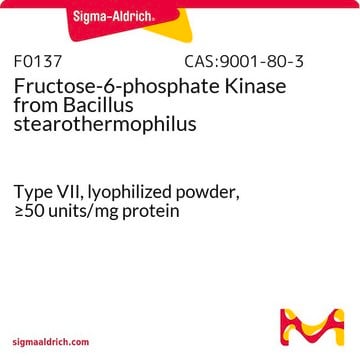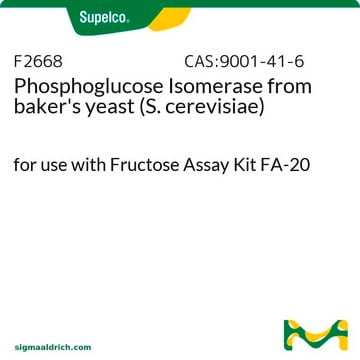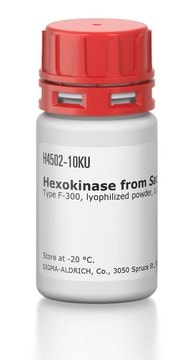P5538
Phosphoglucose Isomerase from Bacillus stearothermophilus
lyophilized powder, 300-1,000 units/mg protein
Synonym(s):
D-Glucose-6-phosphate ketol-isomerase, PGI, Phosphosaccharomutase
Sign Into View Organizational & Contract Pricing
All Photos(1)
About This Item
Recommended Products
form
lyophilized powder
Quality Level
specific activity
300-1,000 units/mg protein
mol wt
189 kDa
composition
Protein, ≥60% biuret
storage temp.
−20°C
General description
The enzyme is part of the glycolytic pathway. Also, it is important in the industrial production of fructose 1,6-diphosphate (FDP) from glucose. The molecular mass is found to be approximately 189 kDa and it consists of four subunits, each with a molecular mass of approximately 50 kDa. Optimum pH is found to be between 9-10 and the isoelectric point is 4.2.
Application
Phosphoglucose Isomerase (PGI) is an enzyme crucial for the interconversion of D-glucose 6-phosphate and D-fructose 6-phosphate. PGI is responsible for the second step of glycolysis and is involved in glucogenesis. It is highly conserved in bacteria and eukaryotes. It is used in sugar assays to convert fructose to glucose. This product is from Bacillus stearothermophilus.
The enzyme from Sigma has been used in the determination of fructose 6-phosphate in a mutant strain of Rhizobium meliloti.
Biochem/physiol Actions
Phosphoglucose Isomerase fuctions as an isomerase, neuroleukin, autocrine motility factor, and a differentiation and maturation mediator.
Unit Definition
One unit will convert 1.0 μmole of D-fructose 6-phosphate to D-glucose 6-phosphate per min at pH 9.0 at 30 °C.
Physical form
lyophilized powder containing Tris buffer
Signal Word
Danger
Hazard Statements
Precautionary Statements
Hazard Classifications
Resp. Sens. 1
Storage Class Code
11 - Combustible Solids
WGK
WGK 3
Flash Point(F)
Not applicable
Flash Point(C)
Not applicable
Personal Protective Equipment
dust mask type N95 (US), Eyeshields, Gloves
Certificates of Analysis (COA)
Search for Certificates of Analysis (COA) by entering the products Lot/Batch Number. Lot and Batch Numbers can be found on a product’s label following the words ‘Lot’ or ‘Batch’.
Already Own This Product?
Find documentation for the products that you have recently purchased in the Document Library.
A Arias et al.
Journal of bacteriology, 137(1), 409-414 (1979-01-01)
A mutant strain of complex phenotype was selected in Rhizobium meliloti after nitrosoguanidine mutagenesis. It failed to grow on mannitol, sorbitol, fructose, mannose, ribose, arabitol, or xylose, but grew on glucose, maltose, gluconate, L-arabinose, and many other carbohydrates. Assay showed
The Kinetics and Mechanism of a Reaction Catalyzed by Bacillus stearothermophilus Phosphoglucose Isomerase.
Widjaja A, et al.
Journal of Fermentation and Bioengineering, 86(3), 324-331 (1998)
Natsuko Miura et al.
Eukaryotic cell, 11(8), 1075-1082 (2012-07-04)
Glycolytic enzymes are cytosolic proteins, but they also play important extracellular roles in cell-cell communication and infection. We used Saccharomyces cerevisiae to analyze the secretory pathway of some of these enzymes, including enolase, phosphoglucose isomerase, triose phosphate isomerase, and fructose
Sean D Schoville et al.
PloS one, 7(6), e40035-e40035 (2012-07-07)
The marine copepod Tigriopus californicus lives in intertidal rock pools along the Pacific coast, where it exhibits strong, temporally stable population genetic structure. Previous allozyme surveys have found high frequency private alleles among neighboring subpopulations, indicating that there is limited
Baiqing Wang et al.
Journal of molecular evolution, 74(1-2), 96-111 (2012-03-06)
Little is known of intron sequences' variation in cases where eukaryotic gene coding regions undergo strong balancing selection. Phosphoglucose isomerase, PGI, of Colias butterflies offers such a case. Its 11 introns include many point mutations, insertions, and deletions. This variation
Our team of scientists has experience in all areas of research including Life Science, Material Science, Chemical Synthesis, Chromatography, Analytical and many others.
Contact Technical Service








